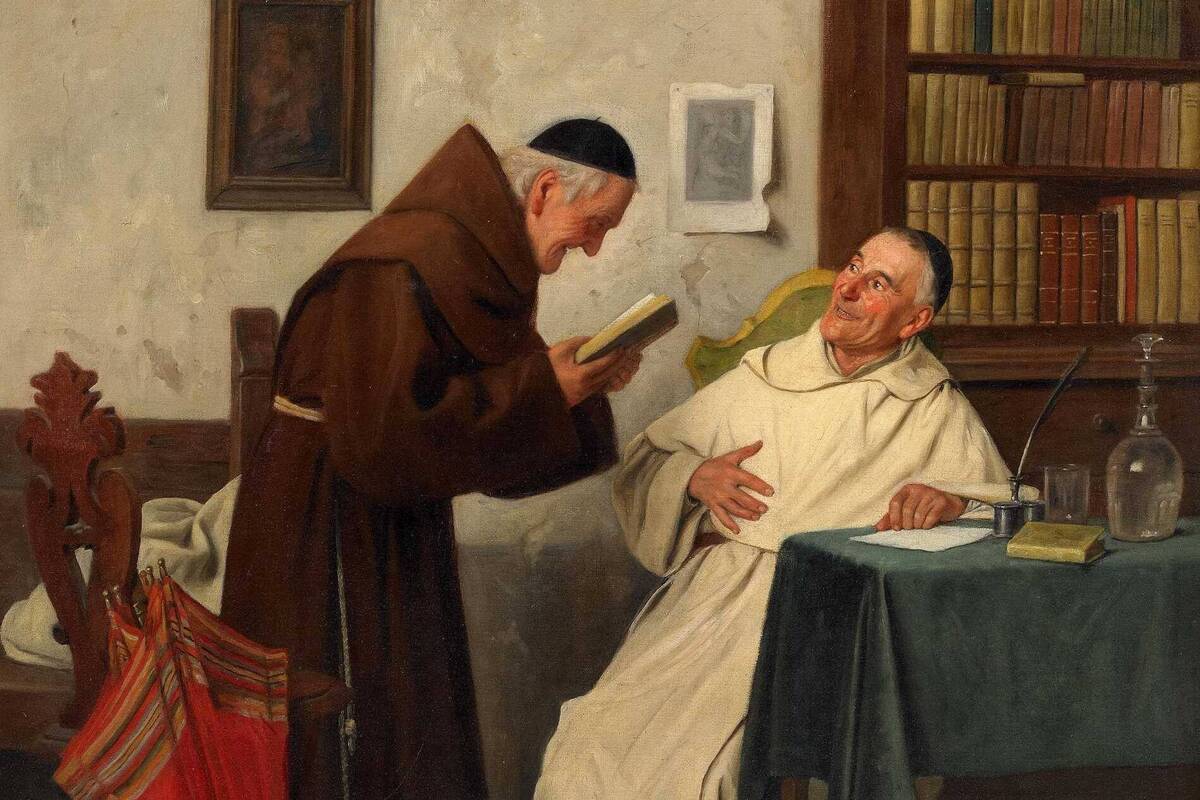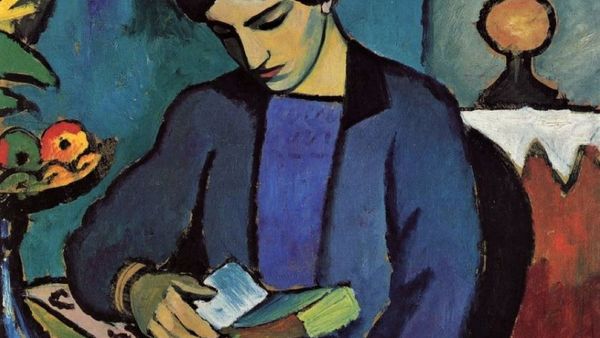Given the hard-earned anticlericalism of our own times, it is unlikely that the short stories and novels of J. F. Powers, whose 1999 obituary headline in The New York Times noted with Powers-esque minimalistic irony that he “wrote about priests,” will experience a revival any time soon. More is the pity. Powers, whose works were already out of print at the time of his death, once counted Saul Bellow and Flannery O’Connor among his fans. Sean O’Faolain called him “a one-man show at the top level of short story writing,” both of Powers’s novels garnered National Book Award nominations, and in 1963 his Morte d’Urban boxed out entries by Nabokov, Updike, and Katherine Anne Porter for that year’s top honor.
While critically heralded and appreciated for its wit and its insight into the gray-flannel-suited aspirations of midcentury American Catholicism, Powers’s work was never popular. His books simply did not sell, not even during the triumphalist days of Fulton Sheen and the Legion of Decency. The overlook may reflect widespread weariness with failings of a clerical Church; it may also owe something to Americans’ tendency to approach religion through the black-and-white lenses of their politics. Writing in The New Yorker, critic Adam Gopnik admired Powers’s capacity for the “heightening of the everyday” but wondered if his waning appeal in the era of declining religious practice had less to do with the writer or his work than with the emergence of “a less, shall we say, catholic” (read: culturally conservative) “self-definition of the faith.”
A closer reading of Powers’s fiction suggests a simpler explanation grounded in the stories themselves. Namely, that these “benevolent portraits of Catholic priests, told from a position of questioning but basically sound faith,” bloom in the soil of intertextual references that yield their full bounty only for those rare readers who share or at least value the author’s humility, his (mostly self-tutored) erudition, and his subtle allusions to what I will call a hidden bookshelf—the treasury of a heart and mind given over to the Church and its long intellectual tradition.
Case in point, “Lions, Harts, Leaping Does” (1943) earned the then-twenty-six-year-old writer his first serious attention and established the subjects and themes that would mark his work over the next five-and-a-half decades. Father Didymus, an elderly Franciscan, is aware of his struggles with vanity and scrupulosity and his attachment to what passes for earthly comfort in the monastery, even as he confronts frailty, death, and uncertainty over the state of his soul. It is late winter, but, far from giving way to spring, the cold and snow persist.
Didymus has denied a summons from his biological brother, Father Seraphin, another nonagenarian, to visit him in St. Louis, choosing to see the trip as an extravagant personal indulgence rather than an act of filial duty or corporal work of mercy. Learning of Seraphin’s death, Didymus suffers a stroke that incapacitates him physically, and he passes the final weeks of his own life perseverating anew over the rottenness of his vows, the meaning of sacrifice, “the means of salvation.”
Didymus’s constant companion in life’s winter twilight is the ancient Brother Titus, a mostly silent sidekick who “knew two books by heart, The Imitation of Christ and The Little Flowers of St. Francis.” These pious selections bespeak the brother’s preference for humility, simplicity, and obedience over the complex moral theology Didymus now chides himself for having “swallowed” over his lifetime. Powers wisely spares his readers book titles, direct quotations or even paraphrases while representing this theology, relying instead on readers to apply their own familiarity or prejudices as they evaluate the interior movements of Didymus’s conscience.
Books are not all that distinguish these old men. “Titus worked in the kitchen and garden” much of his life, performing essential tasks that prick Didymus’s conscience for having merely taught geometry “out of personal preference and perhaps . . . out of pride.” But as Powers’s story opens in Didymus’s tiny cell one dim, frigid evening, Titus has become primarily Didymus’s personal assistant.
This obedience permits the brother to read aloud to the priest—the book of choice, the last of the three titles on the story’s revealed bookshelf, is a collection of short, sardonic papal biographies written by a “heretic,” Bishop John Bale, a Reformation-era prelate of the Church of Ireland. Titus’s assignment also enables the cautious priest to keep an eye on his dear friend, who speaks infrequently and always in quotations from what he has read. Didymus cannot deny himself this entertainment, though he sees the problem clearly:
Two friars had already inquired of Didymus concerning Titus. One had noted the antique style of his words and had ventured to wonder if Brother Titus, Christ preserve us, might be slightly possessed. He cited the case of the illiterate Missouri farmer who cursed the Church in a forgotten Aramaic tongue.
Yet Powers hints throughout the narrative that, far from demonic possession, what the gentle monk suffers is the selective mental debilitations and humiliations of dementia. Didymus understands Titus’s condition even if many of their religious brothers do not, and Powers leaves readers to speculate that the reason Didymus will not openly acknowledge his friend's dementia is that he fears the loss of Titus’s company and needs him too much.
A great deal goes unsaid in “Lions, Harts, Leaping Does,” beginning with the unsubtle but unidentified allusion of Powers’s title, which is a quotation from the Spiritual Canticle of St. John of the Cross, that masterpiece of spiritual writing and of Spanish lyric poetry. The names Powers chooses for his characters are also significant. Titus’s humility and the form of his service to Didymus evoke those of St. Titus to St. Paul the Apostle, whose volubility and preoccupation with moral instruction contrast sharply with the virtual silence of his valued subordinate, about whom the New Testament has little to say.
The power structure in Powers’s tale is similar, if notably self-serving for the priest: Didymus benevolently condescends to his ethereal friend while relying on him to conceal from their religious superior the signs of his own physical and mental decline. Having fallen asleep in the chapel while preparing to celebrate a predawn Mass of remembrance for Seraphin, Didymus awakens to discover that faithful Titus has prepared the sacristy and lit the altar candles while he snored on his kneeler. Didymus takes some comfort that the only witness to his noisy nap was Titus. “Had the sleeping apostles in Gethsemane been glad it was Christ?” he wonders. The memory lingers for Didymus as yet another moment of rueful vanity.
While Didymus-Thomas-twin suffers perpetual doubt about his preparation for death and makes note of Seraphin’s “identical hands” when he meets his late brother in a dream, it is Brother Titus whom the old priest feels compelled to emulate and resemble. Out for a walk together in the cold, “he fell into Titus’s gait. The steps were longer, but there was an illusion of warmth about moving in unison. Bit by bit he found himself duplicating every aspect of Titus in motion.” Returning to the monastery, hyperaware of the frozen discomfort of his own face, nose, and knees, Didymus sees that “Titus, white hair awry in the wind, looked just the same” as he had before they departed. Didymus will also follow Titus into infirmity and, in the story’s closing paragraphs, into holiness and peace: “Even now he could find no divine sign within himself. He knew he still had to look outside, to Titus. God still chose to manifest Himself most in sanctity.” No one would mistake Didymus for Titus, or vice versa, but Titus is nonetheless the priest’s aspirational twin.
Throughout “Lions,” subtle differences between Didymus and Titus trouble the priest’s conscience most. Only for the attentive, extratextual reader will Powers’s allusions to the Canticle and other works deliver these details at their full power. Out on their walk, Didymus balks at the cold, feels “the freezing air bite into his body all over,” and instinctively draws up his cowl. He notices Titus’s feet, “gray and bare in their open sandals,” and the accumulation of ice between Titus’ toes; Didymus scolds himself for wearing heavy woolen socks. Self-recrimination leads the priest into fresh scrupulosity, which Powers renders in contrast with Titus’s unaffected simplicity, and Didymus soon picks his way to “the same bitter conclusion” regarding the salvific impotence of his vows. Sneering at the “poverty” of the “modern friar,” he recalls a quote from Frederick Barbarossa, the twelfth-century Holy Roman Emperor, whose challenge to the wealth of monasteries was but another facet of the reforming impulse that led, some years later, to the establishment of mendicant orders like the Franciscans.
Powers explores these themes of decadence and reform, of conscience and simple sanctity, by way of the two Franciscans’ feet. In the reforming language of yet another century—the sixteenth—Didymus is calced, his feet are protected, he is overly attached to earthly consolations, as were those Carmelite contemporaries of St. John of the Cross who fiercely opposed any changes to the order’s then-relaxed Rule. Titus is discalced. He cares nothing for physical comfort, sleeps with his eyes open, and attends singleheartedly to the service of God like Francis of Assisi, Teresa of Avila, and John of the Cross—who was imprisoned and beaten by those adversarial Carmelites for the privilege.
Reflecting upon the Spanish mystic’s cruel confinement nearly ten years after the publication of “Lions, Harts, Leaping Does,” Thomas Merton—surely one of the more noteworthy and better-prepared readers in Powers’s refined literary circle—leaves one to wonder the extent to which lowly Brother Titus may have influenced his portrait of the Carmelite saint. Writes Merton:
His only excursions from his cell came on the days when he was brought down to the refectory to be publicly scourged by his jailers, who were scandalized at his meek silence, believing it to be the sign of a reprobate conscience, hardened in rebellion. Why didn’t the man do something to defend himself?
Titus’s scourgings are not physical, they are reputational, but like St. John he shows as little vulnerability to others’ opinions as he does to winter’s chill.
We see Titus distressed only twice. The first grief comes when he realizes he has failed to deliver a momentous telegram to Didymus. The second occurs after the canary he has procured for the dying priest flies out the open window of Didymus’s cell. Anguished not for himself but for the priest and the bird, Titus searches the winter landscape for it, unaware that its escape is a consequence for which Didymus, not he, is responsible. As Merton points out, “Sanctity does not consist in suffering. . . . Sanctity itself is a living solution of the problem of suffering.” Titus, like John of the Cross, has learned how to respond to adversity, to desire nothing for himself but to care only for the good of the other.
Unlike so many who suffer dementia, Titus accepts even the loss of his mind with equanimity. “The soul of the contemplative,” Merton writes, “is happy to be reduced to a state of complete loneliness and dereliction in which the most significant renouncement is that of self-complacency.” While Didymus is imprisoned by labyrinthine moral reasoning and physical paralysis, it is not he but Titus with whom the reader familiar with the story of John of the Cross will identify the contemplative saint, who strained to pray the hours in the pale light afforded by the high window of his Toledo prison cell. For Merton, the lions, harts, and leaping does of the Canticle signal a “pure paradise of liberty” made most available to the saint in his hours of distress. In Titus, they become what Merton calls “images of the joys of the spirit, aspects of interior solitude, fires that flash in the abyss of the pure heart whose loneliness becomes alive with the deep lightnings of God.” Titus discovers his leaping does in dementia, that liminal ground between the things of earth and things of heaven.
The “heretical” Bishop Bale’s Pageant of Popes, certainly the least of the religious books on Powers’s revealed shelf in this story, has its uses. Didymus contemplates spiritual lessons in each entry. Pope Anastasius excuses “diseased persons” like Titus from ministry. Pope Zephyrinus models humility in the face of slander. When Titus arrives with the caged canary after Didymus’s stroke, Bale’s book becomes a tool for augury: Titus reads the biography of “Fabius”—Pope Fabian—who is elected when his countrymen see a “pigeon” standing on his head (note Bale’s cheeky substitution for the more pious “dove”).
Wheelchair bound, Didymus involuntarily mimics the canary’s movements with his hands, just as he had earlier matched Titus’s stride. During a reading about Pope Marcellus, who admonished the Roman emperor for persecuting saints, the bird flies at its cage, “its ugly little claws, like bent wire, hooked to the slender bars,” while Didymus’s hands go “tense in his lap.” Taking the bird’s accusation to heart, Didymus orders Titus to leave the room, ostensibly to fetch him a glass of water, then uses his privacy and remaining strength to set the bird free.
Aware he is dying, Didymus asks Titus to select and read from a book at random. Titus opens a commentary on the Spiritual Canticle that analyzes the poem in terms of the irascible and concupiscible faculties St. Thomas Aquinas discusses in questions 23 through 25 of the Summa. Powers leaves the name of the commentary unspecified. Didymus tells Titus to skip the scholastic exegesis, read only John’s verse, and turn out the light. Then, in the throes of a last round of moral scruples, he asks Titus to open the window. At last, Didymus finds he can pray, and the canary rockets out the window into a winter storm.
Is it a stretch here to think of the meditation the king’s counselor offers in St. Bede’s Ecclesiastical History of the English People—one last, sidelong, J. F. Powers wink at a certain kind of reader?
The sparrow, flying in at one door and immediately out at another, whilst he is within, is safe from the wintry tempest; but after a short space of fair weather, he immediately vanishes out of your sight, passing from winter into winter again. So this life of man appears for a little while, but of what is to follow or what went before we know nothing at all.
Titus anguishes over the escape. “How long would it be, Didymus wondered faintly, before Titus ungrievingly gave the canary up for lost in the snowy arms of God?” In a last duplication of the bird’s motion and of Titus’s (a spiritual movement) Didymus releases all doubt and commends his spirit into the wintry night.
Throughout “Lions, Harts, Leaping Does,” J. F. Powers shows us the books that constitute the mind of open Brother Titus while merely hinting at those that inform the subtle, suffering Didymus. Casual readers of The New York Review of Books edition of The Stories of J. F. Powers (2000) may feel this entry stands quirkily on its own as a moving tale of human anxiety on life’s far horizon, of pride and humility rendered in the chiaroscuro tones of twilight. What’s lost? Nothing more or less than the author’s wonderfully wry view of contemporary Catholic moral theology; an enriching meditation on the transcendent and perhaps redemptive aspects of end-of-life enfeeblements; an updated take on eighth-century existentialism, one of the most potently rendered metaphors for life available to us in the canon.
Powers demands a great deal from the would-be allegorical reader—even from many of those who come from within the Catholic milieu, and perhaps more so now than in 1943. Recognizing John of the Cross, Thomas Aquinas, and Bede between Powers’s lines is difficult, but there is little doubt they may be found there. The story holds lessons for writers, too: In “Lions,” Power offers an object lesson in the use of extratextual references and the nearly inevitable tradeoffs between a story’s depth and reach that are commonly risked by writers from any deeply resourced literary tradition. The hidden bookshelf torments poor Father Didymus; it also enriches the contemplations of Powers’s ideal reader.
How many of those was he able to find? Whether Powers at age twenty-six yet understood the limits he was placing on the appeal of his work by his choice of subject and his high expectations of readers’ curiosity is a question for a more definitive biographer to answer.


